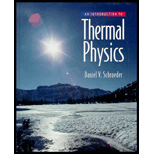Solutions for An Introduction to Thermal Physics
Problem 56P:
Calculate the rate of heat conduction through a layer of still air that is 1 mm thick, with an area...Problem 57P:
Home owners and builders discuss thermal conductivities in terms of the R value (R for resistance)...Problem 58P:
According to a standard reference table, the R value of a 3.5-inch-thick vertical air space (within...Problem 59P:
Make a rough estimate of the total rate or conductive heat loss through the windows, walls, floor,...Problem 60P:
A frying pan is quickly heated on the stovetop to 200C. It has an iron handle that is 20 cm long....Problem 61P:
Geologists measure conductive heat flow out of the earth by drilling holes (a few hundred meters...Problem 62P:
Consider a uniform rod of material whose temperature varies only along its length, in the x...Problem 64P:
Make a rough estimate of the thermal conductivity of helium at room temperature. Discuss your...Problem 66P:
In analogy with the thermal conductivity, derive an approximate formula for the viscosity of an...Problem 67P:
Make a rough estimate of how far food coloring (or sugar) will diffuse through water in one minute.Browse All Chapters of This Textbook
Chapter 1.1 - Thermal EquilibriumChapter 1.2 - The Ideal GasChapter 1.3 - Equipartition Of EnergyChapter 1.4 - Heat And WorkChapter 1.5 - Compression WorkChapter 1.6 - Heat CapacitiesChapter 1.7 - Rates Of ProcessesChapter 2.1 - Two-state SystemsChapter 2.2 - The Einstein Model Of A SolidChapter 2.3 - Interacting Systems
Chapter 2.4 - Large SystemsChapter 2.5 - The Ideal GasChapter 2.6 - EntropyChapter 3.1 - TemperatureChapter 3.2 - Entropy And HeatChapter 3.3 - ParamagnetismChapter 3.4 - Mechanical Equilibrium And PressureChapter 3.5 - Diffusive Equilibrium And Chemical PotentialChapter 3.6 - Summary And A Look AheadChapter 4.1 - Heat EnginesChapter 4.2 - RefrigeratorsChapter 4.3 - Real Heat EnginesChapter 4.4 - Real RefrigeratorsChapter 5.1 - Free Energy As Available WorkChapter 5.2 - Free Energy As A Force Toward EquilibriumChapter 5.3 - Phase Transformations Of Pure SubstancesChapter 5.4 - Phase Tranformations Of MixturesChapter 5.5 - Dilute SolutionsChapter 5.6 - Chemical EquilibriumChapter 6.1 - The Boltzmann FactorChapter 6.2 - Average ValuesChapter 6.3 - The Equipartition TheoremChapter 6.4 - The Maxwell Speed DistributionChapter 6.5 - Partition Functions And Free EnergyChapter 6.6 - Partition Functions For Composite SystemsChapter 6.7 - Ideal Gas RevisitedChapter 7.1 - The Gibbs FactorChapter 7.2 - Bosons And FermionsChapter 7.3 - Degenerate Fermi GasesChapter 7.4 - Blackbody RadiationChapter 7.5 - Debye Theory Of SolidsChapter 7.6 - Bose-einstein CondensationChapter 8.1 - Weakly Interacting GasesChapter 8.2 - The Ising Model Of A FerromagnetChapter A.1 - Evidence For Wave-particle DualityChapter A.2 - WavefunctionsChapter A.3 - Definite-energy WavefunctionsChapter A.4 - Angular MomentumChapter A.6 - Quantum Field TheoryChapter B.1 - Gaussian IntegralsChapter B.2 - The Gamma FunctionChapter B.3 - Stirling's ApproximationChapter B.4 - Area Of A D-dimensional HypersphereChapter B.5 - Integrals Of Quantum Statistics
Book Details
I. FUNDAMENTALS.
1. Energy in Thermal Physics.
2. The Second Law.
3. Interactions and Implications.
II. THERMODYNAMICS.
4. Engines and Refrigerators.
5. Free Energy and Chemical Thermodynamics.
III. STATISTICAL MECHANICS.
6. Boltzmann Statistics.
7. Quantum Statistics.
8. Systems of Interacting Particles.
Appendix A. Elements of Quantum Mechanics.
Appendix B. Mathematical Results.
Reference Data.
Suggested Reading.
Sample Solutions for this Textbook
We offer sample solutions for An Introduction to Thermal Physics homework problems. See examples below:
Chapter 1.7, Problem 56PChapter 2.6, Problem 28PGiven: The entropy of an ideal gas is, S=Nk[ln(2πmAU ( Nh ) 2)+2] Calculation: To get the...Chapter 4.4, Problem 29PGiven: The chemical reactions are 2H ↔ H2 ……. (1) 2CO + O2 ↔ 2CO2 …… (2) CH4 + 2O2 ↔ 2 H2O + CO2 ……....Given: The equilibrium temperature of an ideal gas is T . Formula used: Write the expression for the...Given: The given integral is ∫0∞xex−1dx . Formula used: Write the value of standard integral....Chapter 8.2, Problem 15PFormula used: Total energy within the box can be written as: E=2∑ n x ∑ n y ∑ n z ε( n → ) =2∭ε( n →...
More Editions of This Book
Corresponding editions of this textbook are also available below:
An Introduction To Thermal Physics
1st Edition
ISBN: 9789332535077
Related Physics Textbooks with Solutions
Still sussing out bartleby
Check out a sample textbook solution.
